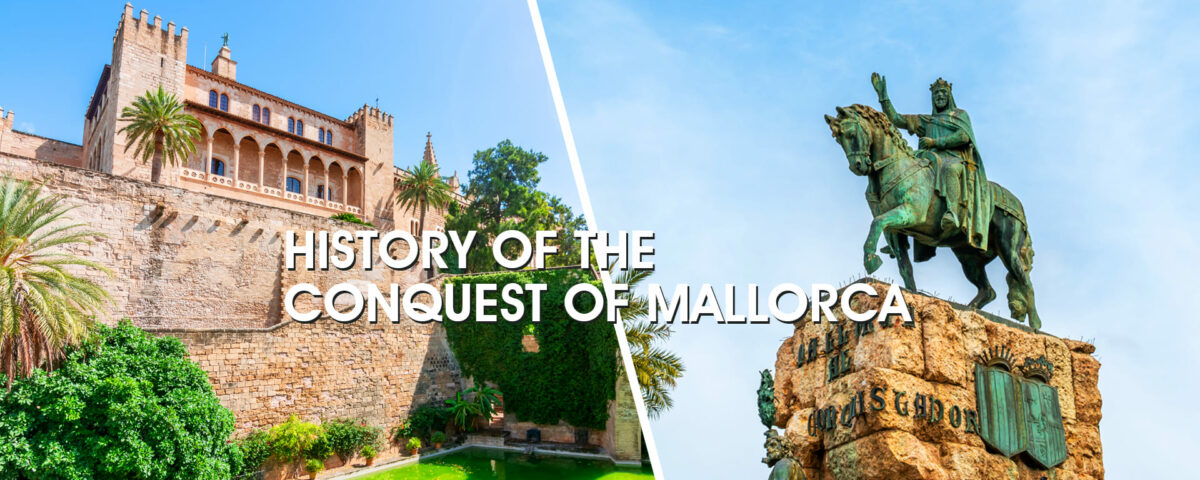History of the conquest of Mallorca
Christians, Romans and Moors have all left their mark on the beautiful old town of Palma de Mallorca. The Almudaina Royal Castle is the official residence of the current monarchs Its name means "fortress" in Arabic. Also reminiscent of the Moorish period on the island are the nearby baths.
After the defeat of the Moors at the Battle of Navas de Tolosa (1212), Jaime I set about expanding his empire in the Mediterranean. This process formed an important part of the project and was carried out from 1228 promoted by the monarch. On September 5, 1229, the Christian fleet set sail from Salou, Cambrils and Tarragona and headed for Mallorca. The fleet consisted of 150 ships at that time. Most of them come from Catalonia. It is said that 800 knights and thousands of soldiers were involved.
On 5 September 1229, the Christian fleet set sail from Salou, Cambrils and Tarragona and set course for Mallorca. At that time, the fleet consisted of 150 ships. Most of them came from Catalonia. It is said that 800 knights and thousands of soldiers were involved. The troops of Jaime I landed in Santa Ponça and defeated the Moors in the Battle of Portopi on 13 September 1229. A cross was erected in Santa Ponça to commemorate this event, which is celebrated on the same date. In this celebration, the arrival of the troops is re-enacted.
After numerous battles, Jaime I finally succeeded in taking Madina Mayurqua on 31 December 1229.
The Christians murdered the last Moorish ruler, Abú Yahya. They burned the city and killed the population. So many people died at that time that it was impossible to bury all the bodies. It was decided to decimate the troops through a plague epidemic. The nobles who took part in the conquest decided to keep the stolen goods for themselves and did not divide them among the troops. The soldiers, however, protested and eventually each of the men got his share.
The sacking of the city lasted until 30 April 1230, and the Moors who managed to escape organized themselves in the Serra de Tramuntana. From there they defied the Christians for 2 years. Towards the end of 1232, the entire territory was finally taken by the Christians.
When the Christian king Jaime I conquered Mallorca in 1229, the Moorish structure was adapted or demolished. There are now 55 churches in the capital alone. These were built over several centuries and most show Gothic and Baroque influences.
The 17th and 18th century mansions are characteristic of Palma's old town. A large number of them have been skillfully restored and some have even been converted into luxurious boutique hotels. Nevertheless, the courtyards of these houses in particular still betray their ancient history. At the turn of the 20th century, Catalan modernism arrived on the island; the Grand Hotel as well as Can Casasayas in the Plaza del Mercat are excellent examples of this trend.
Sights in the old town
The "Parc de la Mar" refers to the artificial lake directly in front of the cathedral, which was created underneath the wall in the 1970s. During the early hours of the morning, the cathedral's spectacular window roses are particularly well accentuated by the incident sunlight.
Another architectural gem is the historic building La Lonja, located in the neighborhood of the same name, not far from the cathedral. This building was the seat of the maritime trade exchange. It is now freely accessible. The square in front of La Lonja has a few restaurants where you can sit outside and relax.
Because of its rich history and culture, there is much to see and do in the old town. You can join one of the many tours we have listed for you on our site. Be it on foot or by hop on hop off bus.
The lively shopping street Sant Miquel stretches all the way to the impressive Plaça Major. On Plaça Cort you can admire the elaborate façade of Palma's town hall and the 600-year-old olive tree that has taken root here as a symbol of peace.
History of the Conquest of Mallorca
The “History of the conquest of Mallorca” is an intriguing tale of power, religion, and cultural assimilation. The beautiful old town of Palma de Mallorca bears the imprints of Christians, Romans, and Moors who have all left their mark over the centuries.

The Almudaina Royal Castle, the official residence of the current monarchs, stands as a testament to this rich history. Its name, meaning fortress in Arabic, is a hint at the Moorish period on the island. The nearby baths further echo this era.
The Christian Conquest and the Battle of Navas de Tolosa
After the defeat of the Moors at the Battle of Navas de Tolosa in 1212, Jaime I embarked on expanding his empire in the Mediterranean. The “History of the conquest of Mallorca” formed an important part of this project, initiated in 1228 by the monarch himself. On September 5, 1229, the Christian fleet, consisting of 150 ships, set sail from Salou, Cambrils, and Tarragona, heading for Mallorca.
The Landing in Santa Pona and the Battle of Portopi
The troops of Jaime I landed in Santa Pona and defeated the Moors in the Battle of Portopi on 13 September 1229. A cross was erected in Santa Pona to commemorate this event, which is celebrated annually. The arrival of the troops is re-enacted during this celebration.
After numerous battles, Jaime I finally succeeded in taking Madina Mayurqua on 31 December 1229. The Christians murdered the last Moorish ruler, Ab Yahya, and a wave of violence ensued, resulting in a high death toll. The nobles who took part in the conquest decided to keep the stolen goods for themselves, leading to protests from the soldiers. Eventually, each man received his share.
The Christian Reign and the Transformation of Mallorca
The sacking of the city lasted until 30 April 1230, and the Moors who managed to escape organized themselves in the Serra de Tramuntana. From there, they defied the Christians for 2 years. By the end of 1232, the entire territory was finally taken by the Christians.
When the Christian king Jaime I conquered Mallorca in 1229, the Moorish structure was adapted or demolished. Today, there are now 55 churches in the capital alone, built over several centuries, with most showing Gothic and Baroque influences.
The 17th and 18th-century mansions are characteristic of Palma’s old town. Many of them have been skillfully restored, and some even converted into luxurious boutique hotels. However, the courtyards of these houses still betray their ancient history. At the turn of the 20th century, Catalan modernism arrived on the island, with the Grand Hotel and Can Casasayas in the Plaza del Mercat being excellent examples of this trend.
Because of its rich history and culture, there is much to see and do in the old town. You can join one of the many tours we have listed for you on our site, be it on foot or by hop-on-hop-off bus.
The lively shopping street Sant Miquel stretches all the way to the impressive Plaça Major. On Plaça Cort, you can admire the elaborate façade of Palma’s town hall and the 600-year-old olive tree that has taken root here as a symbol of peace.


